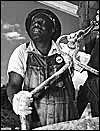| 1933 |
March -- Before a crowd of 100,000
at the Capitol Plaza in Washington, D.C., Franklin Delano Roosevelt is
inaugurated president. FDR tells the crowd, "The people of the United States
have not failed. In their need they have registered a mandate that they
want direct, vigorous action. They have asked for discipline and direction
under leadership. They have made me the present instrument of their wishes.
In the spirit of the gift I take it."
FDR announces a four-day bank holiday to begin on Monday,
March 6. During that time, FDR promised, Congress would work on coming
up with a plan to save the failing banking industry. By March 9, Congress
passed the Emergency Banking Act of 1933. By month's end, three-quarters
of the nation's closed banks were back in business.
On March 12, FDR delivers the first of what came to be
known as his "fireside chats." In his initial "chat" he appealed to the
nation to join him in "banishing fear." |
|
April -- President Roosevelt, under the Emergency
Banking Act, orders the nation off of the gold standard.
| The Civilian Conservation Corps (CCC) is established.
Designed as a relief and employment program for young men between the ages
of 17 and 27, the CCC was envisioned by FDR as a kind of volunteer "army"
that would work in national forests, parks, and federal land for nine-month
stints. The first 250,000 young men were housed in 1,468 camps around the
country. At its peak in 1935, the CCC would include 500,000 young men. |
 |
|
|
May -- The Federal Emergency Relief Administration
is created by Congress. President Franklin Roosevelt appointed Harry L.
Hopkins as its chief administrator. By the end of his first day on the
job, Hopkins had issued grants totaling more than $5 million.
The National Industrial Recovery Act is introduced into
Congress. Under Title I of the act, the National Recovery Administration
was designated to maintain some form of price and wage controls. Section
7(a) of the act guaranteed labor the right to organize and bargain collectively.
As part of the act, The National Labor Board was set up to negotiate disputes
between labor and management. |
|
| The Tennessee Valley Authority is created. A federally
run hydroelectric power program, the TVA act was considered a huge experiment
in social planning. The TVA also built dams, produced and sold fertilizer,
reforested the Tennessee Valley area, and developed recreational lands.
Opponents of the TVA called it "communistic to its core." |
 |
|
|
June -- Congress passes the Glass-Steagall act
that separated commercial from investment banking and set up the Federal
Deposit Insurance Corporation to guarantee bank deposits. |
|
| August -- With an eye toward organizing
farmers into soil conservation districts, the federal government establishes
the Soil Erosion Service. The creation of this service was made necessary
by the years of drought and dust that plagued the Southwestern Panhandle
states. |
 |
|
|
September -- In an effort to stabilize prices,
the federal agricultural program orders the slaughter of more than 6 million
pigs. Many citizens protested this action since most of the meat went to
waste. |
|
October -- The Civil Works Administration is established.
Devised as a wide scale program that could employ up to 4 million people,
the C.W.A was involved in the building of bridges, schools, hospitals,
airports, parks and playgrounds. Additionally, C.W.A. funds went toward
the repair and construction of highways and roads. Early in 1934, Congress
authorized $950 million for the continued operation of the C.W.A. |



